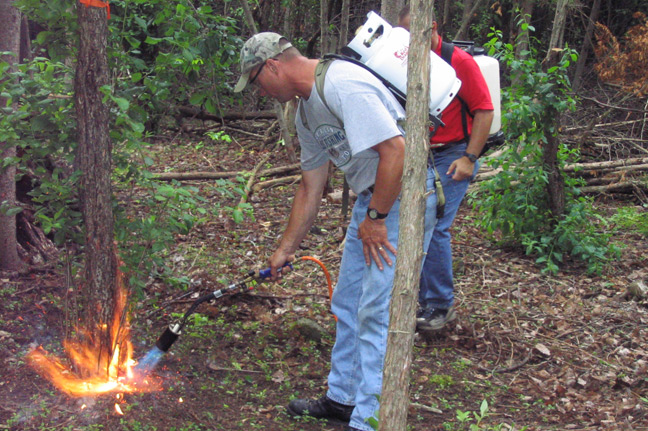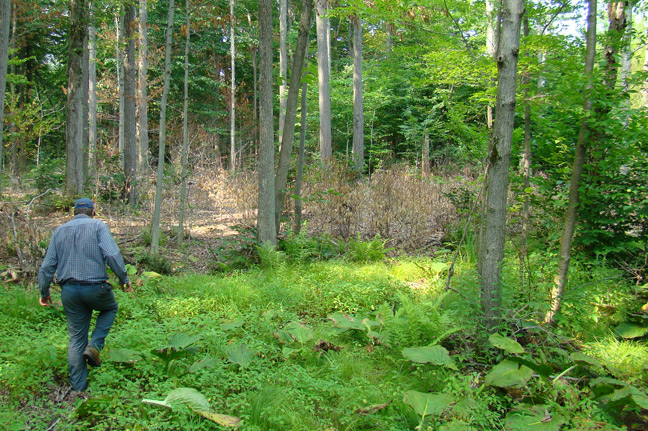Cornell Corner
Some strategies to control American beech
Mechanical and chemical methods have useful applications
By PETER SMALLIDGE |
American beech and many other native and non-native woody plants can dominate a woodland, exclude or limit the regeneration of desired plant species, and limit the biodiversity of the site. In high abundance, these species can complicate access for maple producers. Often these interfering species gain dominance because of selective deer browsing of desired plant species, and prolonged deer pressure can create a legacy effect that persists even if deer impacts are controlled.
In all forest vegetation management situations, not exclusive to beech, you should start with a plan that details the interfering species, the desired plant species, the costs, how the interfering vegetation will be treated, and how the site will be re-vegetated. Webinar archives detailing the vegetation management planning process are available at www.youtube.com/ForestConnect. The word “treatment” is used here to describe the manner in which the vegetation is manipulated, often with the goal of killing the stems causing the interference. The treatment has two attributes – the method and the mode. Method is typically mechanical or chemical and mode is either broadcast or selective. Biocontrol methods are not described here. Each treatment can be describe by a method and a mode. First we will review some principles, then consider some examples.
Which Method and Which Mode?
Both mechanical and chemical methods have useful applications. Often the choice depends on the attitude of the owner, the time of year, the terrain, or the equipment. For some circumstances, a mechanical method is followed by a chemical method. Mechanical methods might include hand-pulling, brush saws and chain saws, timber ax and Fecon mowers, or livestock. Chemical treatments are herbicides, a type of pesticide that targets plants.
The decision about whether to use chemical methods may be decided by the owner’s attitudes and comfort with the use of herbicides. Some owners, such as maple produces who are certified organic, are restricted from using most conventional herbicides. Herbicides are regulated by the EPA through authority given to the NYS DEC. The regulatory process helps inform users about the known ways that the active ingredients will behave in the environment. If an owner uses an herbicide, they should carefully follow the label. Home recipes of chemical concoctions should never be used.
Mode is selected depending on the desired specificity of the treatment to individual or groups of stems. A selective treatment affects individual stems and a broadcast treatment affects all stems in an area. If an interfering species is mixed with a high percentage of a desired species, a selective treatment may be used to reduce injury to the desired species. Selectivity is possible through physically isolating one stem from others, by using a treatment that only affects a certain species, or by applying a treatment at a time of year when desirable species are not susceptible. If the interfering species predominates, or financial or logistical constraints preclude a selective treatment then a broadcast treatment would be applied.
The abundance of undesired stems is often a good place to start when considering whether to use a selective or broadcast mode. The principle to consider here is the fixed cost to visit each stem in a selective treatment. If there are too many stems per acre that means (1) the cost per acre will become prohibitive and (2) because there are a fixed number of stems per acre the interfering stems have likely displaced the desirable stems and a broadcast treatment would have limited relative collateral damage. Although not widely studied, the threshold between selective and broadcast is about 400 stems per acre. Each owner’s situation is a bit different, so this threshold should only be used as a guide.
Selective Manual
ν Types of treatments would include pulling, girdling or cutting.
ν Pulling treatments are best applied in circumstances of small plants, where the interfering plant has only recently been established and there is little potential for subsequent seed input from that plant. Pulling has the potential negative consequence that the soil is disturbed and the exposed mineral soil may provide a suitable seedbed for some other undesirable species.
ν Girdling severs the phloem and vascular cambium just inside the bark. Girdling can be accomplished with an ax, saw, or flame torch; chemical girdling is called basal bark and described below. Girdling has the advantage of more quickly treating the stems as compared to cutting and not needing to immediately address the downed stem. Stem size matters because a large dead tree may become a hazard in the future. This treatment can be combined with a frill herbicide application (see “hack-n-squirt” below) as an integrated strategy.
ν Cutting uses a saw to sever the stem and fully disconnect the foliage from the roots. Traditional timber stand improvement with firewood as a product is an example of this treatment. Special safety concern is warranted for those who use a chainsaw. Also, in most hardwoods and shrubs, cutting will stimulate stump sprouting, and also root sucker sprouts from beech and tree-of-heaven. Shade intolerant species such as black locust and aspen may develop root sucker thickets after cutting if enough light is available. This treatment can be combined with an herbicide application to the cut surface (see “cut-stump” below) as an integrated strategy to prevent sprouting.
Selective Chemical
ν Types of treatments include foliar, hack-n-squirt (AKA injection), cut-stump, and basal bark.
ν Treatments can be quick, cost-effective and reduce or typically eliminate the potential for post-treatment sprouting from stumps or roots.
ν Treatments require the use of a chemical, but the chemical is used on individual stems to reduce the potential for collateral damage.
ν Information about all herbicides that are legal for use in NY is available at www.pims.psur.cornell.edu
ν Foliar treatments are applied to individual plants. Applications of foliar sprays on tall or broad plants may result in overspray and a heightened potential for drift onto adjacent plants. Foliar treatments are commonly a low concentration of glyphosate (e.g., Roundup) or triclopyr (e.g., Garlon 4 ultra) perhaps mixed with imazapyr (e.g., Arsenal, Polaris AC) or sulfometuron methyl (e.g., Oust). The herbicide labels will describe mixing ratios. Foliar treatments can be applied following a mechanical cutting, after stems sprout new foliage, thus allowing for the use of less chemical and greater control.
ν Hack-n-squirt treatments use a hatchet or similar tool to expose the phloem, vascular cambium and outer most xylem tissues, the wood, to a fairly concentrated (25% to 50% active ingredient) application of glyphosate. Imazapyr might also be used to control some species. The role of the hatchet is to expose the inner wood; other tools might include a portable drill or divots made by a chainsaw. The objective is to make multiple relatively small wounds that receive an application of the herbicide.
ν Cut-stump treatments are appropriate when the stem is severed, but without additional treatment the stump or roots will sprout. Herbicides might include glyphosate or triclopyr. Glyphosate is mobile in the root system and will be translocated from the stump to root sprouts that are controlled. Triclopyr is less mobile than glyphosate. Follow label details, but herbicides are typically applied to the outer 2 inches of the freshly cut stump surface or to the entire surface and sides of the stump. Recent research on glyphosate (J. Kochenderfer, USFS) found that glyphosate could be applied up to 72 hours after the beech tree was cut with minimal reduction in control of root sprouting.
ν Basal bark treatments use an herbicide, typically triclopyr, in an oil-based carrier to chemically girdle a stem. As with mechanical girdling, the full circumference must be treated. Treated stems seldom if ever sprout. Details are provided in the link below, but lower doses and broader seasonal opportunities exist than were previously considered.
Broadcast Manual
ν In woodland settings, there are few options for broadcast manual treatments. These include rotary brush heads on small tracked machines and management intensive grazing.
ν Small tracked machines (e.g., Fecon, Timber Ax) can maneuver in many wooded settings and clear vegetation in the lower strata. Depending on the operator, these have some ability for selectively avoiding some desired stems. As with selective manual, this treatment may stimulate root and stump sprouting.
ν Management intensive grazing is grazing strategy often used in silvopasture systems. It requires a high level of grazier awareness and understanding. Management intensive grazing might be preceded by a rotary mower as described above.
Broadcast Chemical
ν Broadcast chemical treatments are only used when interfering stems fully and almost exclusively dominate the site, and the foliage is at a height where it is accessible to spray equipment.
ν Because broadcast chemical treatments opens the entire understory, care must be taken to monitor the species that re-occupy the site to assure other interfering species don’t assume dominance.
ν A few isolated desired species can often be protected by clipping them at ground level just before spraying. The lack of foliage protects the clipped stems and most will resprout.
ν Broadcast chemical treatments are essentially foliar treatments, but done with equipment that sprays broad areas rather than selective targets. In some situations, this treatment is the most efficient and provides the best control of interfering species. Both backpack and tractor/skidder mounted sprayers are available.
Online support to further understand and visualize treatments include the following:
ν A good internet source to understand forest vegetation management is provided by Penn State Cooperative Extension at www.extension.psu.edu/fvm.
ν Chemical selective treatments www.youtube.com/ForestConnect
ν Manual herbicide application methods http://www.nrs.fs.fed.us/pubs/gtr/gtr_nrs96.pdf
ν Silvopasture (i.e., sustainable woodland grazing) http://www2.dnr.cornell.edu/ext/info/pubs/MapleAgrofor/Silvopasturing3-3-2011.pdf
Peter Smallidge is the NYS Extension Forester and Director of Arnot Teaching and Research Forest, Department of Natural Resources with the Cornell University Cooperative Extension in Ithaca, NY 14853. Support for ForestConnect is provided by USDA NIFA and the Cornell University College of Agriculture and Life Sciences.
August/September 2015

































